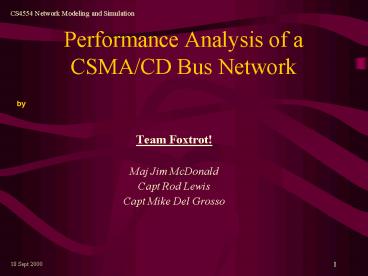Performance Analysis of a CSMACD Bus Network - PowerPoint PPT Presentation
1 / 35
Title:
Performance Analysis of a CSMACD Bus Network
Description:
Analyzing and modeling these networks can also help plan for network growth and adjustments. ... Analytical modeling produced acceptable solutions for the ... – PowerPoint PPT presentation
Number of Views:62
Avg rating:3.0/5.0
Title: Performance Analysis of a CSMACD Bus Network
1
Performance Analysis of a CSMA/CD Bus Network
CS4554 Network Modeling and Simulation
by
- Team Foxtrot!
- Maj Jim McDonald
- Capt Rod Lewis
- Capt Mike Del Grosso
18 Sept 2000
2
Presentation agenda
- Define Problem
- State Goal
- Assumptions
- Network Description
- Performance Metrics
- Workload
- Analytical Model of CSMA/CD Network
- Simulation Demonstration
- Conclusions
- Lessons learned
3
Define Problem
A very common network today is the CSMA/CD or
Ethernet network. It is important to establish
the performance characteristics of networks
before putting them to use. This will assist in
keeping them from becoming overloaded so they
provide the best service possible to its users.
Analyzing and modeling these networks can also
help plan for network growth and adjustments.
4
Goal Statement
- Complete an analytical model and a simulation
model of a CSMA/CD (Ethernet) network and compare
the evaluation techniques results.
5
Assumptions
- When one or more bits overlap in time all are
lost and must be retransmitted. - All nodes listen constantly to the bus and only
transmit if there is no transmission already on
the bus. - If there is no transmission on the bus any node
with available data can transmit immediately - System performs the service correctly
6
Bus Network
- Description of Simulated Bus Network
7
Performance Metrics
- We used a simplified example of a Bus Network for
our project, which includes - 1. Performance is measured by the time taken to
perform the service - 2. The rate at which the service is performed
- 3. The resources consumed while performing the
service - SMART - Specific, Measurable, Acceptable,
Realizable and Thorough
8
Performance Metrics
- Speed
- The access delay at any station should be less
than 1 second - Sustained throughput must be at least 10
Mbits/sec - Reliability
- The probability of any bit being in error must be
less than - The probability of any frame being in error must
be less than 1 - The probability of any frame in error being
delivered without error indication must be less
than
9
Performance Metrics
- Availability
- The mean time to initialize the LAN must be less
than 15 milliseconds. - The mean time between LAN initializations must be
at least 1 minute. - The use of the analytical model checks the
realizability of all our numerical values.
10
Test Workload
- System Under Test
- 1.There are 10 nodes attached to the network.
- 2. Bus length is 40 meters.
- 3. Fixed packet length. 2.
- Workload Areas of OSI 7 layer Model
- Datalink Layer - transmission of frames over a
single link - Network Layer - distance between source and
destination and the characteristics of packets
transmitted - Transport Layer - specifying the frequency sizes
and other characteristics of various messages
11
Test Workload
- Loading Level - is of a typical case
- (not full capacity or worst case)
- No significant impact of external components.
- This workload can be easily repeated.
12
Analytical Model
- Type of network analyzed - M/M/1
- Inter-arrival times and Service Times are
exponentially distributed and there is one server - State transition diagram for an M/M/1 queue
...
13
Simulation ModelPlanning
- SMART Goal
- Level of detail is identified
- Background of team
- some programming, management level knowledge,
eager - Time - big issue
14
Simulation Model
- Random number generator checked
- Uniformity and Independence
- Results reviewed on a constant basis
- Documentation given in the form of final report
- Length of time run was appropriate
- V and V...
15
Validation and Verification
- Coming from the the phrase until validated,
all evaluation results are suspect - Use the rules
- Do not trust the results of a simulation model
until they have been validated by an analytical
modeling or measurements. - Do not trust the results of an analytical model
until they have been validated by a simulation
model or measurements.
16
Analytical Model
- Mean service time
- Mean arrival rate
- Total arrival rate
17
Analytical Model
- Traffic intensity
- End-to-end propagation delay
- For constant packet lengths
18
Analytical Model
- Mean delay
19
Analytical Model
20
Analytical Model
21
Analytical Model
22
Analytical Model
23
Simulation Model
- Use the OPNET modeler to simulate an M/M/1/B
queue - Validate the results with an analytical model
(M/M/1/B)
The goal of the study is to evaluate and compare
the CSMA/CD Bus Network with an acceptable loss
rate.
24
Profile Setup
25
Bus Utilization
26
WorkStation Delay
27
Load (packet/sec)
28
Delay(sec)
29
Bus Load
30
Network Delay
31
Validation and Verification
- Delay differences
- Inaccurate propagation delay b/n analytical and
simulation - Definition of Light and Heavy unknown.
- Simulation is unknown
- Analytical model is hard numbers
32
Conclusions
- The initial problem was strongly bound so that
analytical modeling of the proposed network could
be performed with available tools. - Analytical modeling produced acceptable solutions
for the given problem and considering stated
assumptions. - Opnet Modeler is a very powerful simulation tool.
It also requires extensive training to be able to
produce correct and useful models.
33
Lessons Learned
- Follow the directions in the readings!
- You cant jump into a simulation tool or analyze
someones code within a very constrained time
frame. - Need more time to learn simulation tool given.
- Focus and scaling of the problem/exercise.
34
Questions?
35
Thank You































